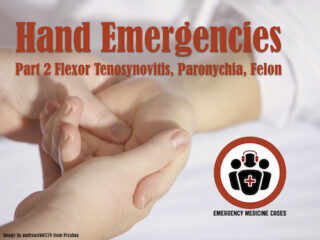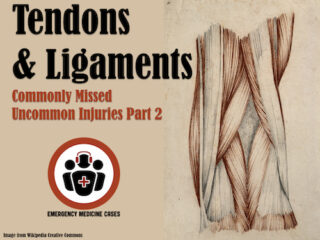
Episode 29b: Hand Emergencies Part 2
Part 2 of Hand Emergencies with Dr. Laura Tate & Dr. Andrew Arcand.
Episode 58: Tendons and Ligaments – Commonly Missed Uncommon Orthopedic Injuries Part 2
In part 2 of our round-table discussion on EM Cases with sports medicine guru Dr. Ivy Cheng and orthopedic surgeon Dr. Hossein Mehdian we elucidate some key commonly missed uncommon orthopedic injuries that if mismanaged, carry significant long term morbidity. Injuries of the tendons and ligaments are often overlooked by emergency providers as relatively benign injuries and generally are not well understood. Syndesmosis Injuries typically occur in impact sports. They are missed in about 20% of cases, as x-rays findings are often subtle or absent. The mechanism, physical exam findings, such as the Hopkin's Test, and associated injuries are important to understand to help make the diagnosis and provide appropriate ED care. Distal Biceps Tendon Rupture is almost exclusively a male injury and occurs in a younger age group compared to the Proximal Biceps Rupture. It is important to distinguish these injuries as their management and outcomes are different. The mechanism and physical exam findings of Distal Biceps Tendon Rupture, such as the Hook Test, are key in this respect. Quadriceps Tendon Rupture is often misdiagnosed as a simple ‘knee sprain’, but should be consideration for surgical intervention. Quadriceps tendon ruptures are more commonly seen in patients older than 40 years and are more common than patella tendon ruptures which are more commonly seen in patients under 40 years of age. Interestingly, up to 1/3 of patients present with bilateral quadriceps tendon ruptures, so comparing to the contralateral knee may be misleading. There is a spectrum of knee extensor injuries that should be understood in order to provide proper care, with the Straight-Leg-Raise Test being abnormal in all of them. This is of the most important physical exam maneuvers to perform on every ED patient with a knee injury. The x-ray findings of these injuries may be subtle or absent, and proper immobilization of these injuries is important to prevent recoil of the tendon. Patients with calf pain and Gastrocnemius Tears are often misdiagnosed as having a DVT. In fact, one small study showed that gastrocnemius tears were misattributed to DVT in 29% of patients. This confusion occurs because sometimes patients who suffer a gastrocnemius tear report a prodrome of calf tightness several days before the injury, suggesting a potential chronic predisposition. With a good history and physical, and POCUS if you’re skilled at it, needless work-ups for DVT can be avoided. For well thought out approaches, pearls and pitfalls, to these 4 Commonly Missed Uncommon Orthopedic Injuries, listen to the podcast and read the rest of this blog post....
Episode 57: The Stiell Sessions 2 – Update in Atrial Fibrillation 2014
In this bonus EM Cases podcast, The Stiell Sessions 2, we have Dr. Ian Stiell discussing an update in Atrial Fibrillation 2014 management including the age-old question of rate control vs rhythm control, the new CHADS-65 algorithm for oral anticogulant therapy, the need to initiate anticoagulant therapy in the ED, the more aggressive use of the Ottawa Aggressive Protocol, the dangers of attempting to cardiovert unstable patients who are in permanent Atrial Fibrillation, the new 150 rule to help determine the likelihood of successful cardioversion and much more. Thanks to all the listeners who did the survey on clinical decision rules and the post-listen survey.
Episode 56 The Stiell Sessions: Clinical Decision Rules and Risk Scales
There are hundreds of clinical decision rules and risk scales published in the medical literature, some more widely adopted than others. Ian Stiell, the father of clinical decision rules, shares with us his views and experiences gained from co-creating some of the most influential CDRs and risk scales to date. He explains the criteria for developing a CDR, the steps to developing a valid CDR, how best to apply CDRs and risk scales to clinical practice, and the hot-off the-press new Ottawa COPD Risk Score and Ottawa Heart Failure Risk Score for helping you with disposition decisions. It turns out that in Canada, we discharge about two thirds of the acute decompensated heart failure patients that we see in the ED, while the US almost all patients with decompensated heart failure are admitted to hospital. Dr. Stiell's new risk scores may help physicians in Canada make safer disposition decisions while help physicians in the US avoid unnecessary admissions.
Episode 55: Fluids in Sepsis, Post-intubation Analgesia and Sedation
In this second part of the Weingart-Himmel Sessions on critical care pearls for the community ED on the EM Cases podcast, we discuss the many controversies and recent changes in fluid management in severe sepsis and septic shock. With the recently published ARISE trial, and some deviations from Early Goal Directed Therapy, we are changing the way we think about fluids in sepsis: the type of fluid, the volume of fluid, the rate of fluid administration, the timing of introducing vasopressors and the goals of fluid resuscitation. In the next section of the podcast we discuss the PAD mnemonic for post-intubation analgesia and sedation, the prevention of delirium, and medication choices to minimize time on the ventilator, and improve prognosis.
Episode 54: Preoxygenation and Delayed Sequence Intubation
Hot on the heels of Dr. Weingart's latest publication in the Annal of EM on Preoxygenation & Delayed Sequence Intubation, we have Dr. Weingart, perhaps the world's most influential critical care educator, and Dr. Walter Himmel, 'The Walking Encyclopedia of EM' discussing how the community ED doc can use preoxygenation, apneic oxygenation and delayed sequence intubation to help improve airway management knowledge and skills. Whether you work in a rural setting or a big urban community hospital, Dr. Himmel and Dr. Weingart explain how these concepts and skills are easily adaptable to your work environment. We introduce the Triple 15 Rule for preoxygenation as a memory aid that will help you the next time you're faced with a critically ill patient who's oxygen saturation isn't good enough on a non-rebreather.







